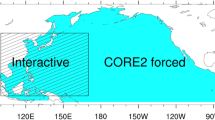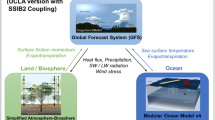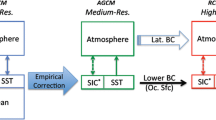Abstract
This work evaluates the added value of the downscaling technique employed with the Eta model nested in the CPTEC atmospheric general circulation model and in the CPTEC coupled ocean–atmosphere general circulation model (CGCM). The focus is on the austral summer season, December–January–February, with three members each year. Precipitation, latent heat flux, and shortwave radiation flux at the surface hindcast by the models are compared with observational data and model analyses. The global models generally overestimate the precipitation over South America and tropical Atlantic. The CGCM and the nested Eta (Eta + C) both produce a split in the ITCZ precipitation band. The Eta + C produces better precipitation pattern for the studied season. The Eta model reduces the excessive latent heat flux generated by these global models, in particular the Eta + C. Comparison against PIRATA buoys data shows that the Eta + C results in the smallest precipitation and shortwave radiation forecast errors. The Eta + C comparatively best results are though as a consequence of both: the regional model resolution/physics and smaller errors on the lateral boundary conditions provided by the CGCM.

















Similar content being viewed by others
References
Altshuler E, Fennessy M, Shukla J, Juang H, Rogers E, Mitchell K, Kanamitsu M (2002) Seasonal simulations over North America with a GCM and three regional models. COLA Tech. Rpt. 115. http://www.iges.org/pubs/tech.html
Amengual A, Romero R, Homar V, Ramis C, Alonso S (2007) Impact of the lateral boundary conditions resolution on dynamical downscaling of precipitation in Mediterranean Spain. Clim Dyn 29:487–499. doi:10.1007/s00382-007-0242-0
Antic S et al (2006) Testing the downscaling ability of a one-way nested regional climate model in regions of complex topography. Clim Dyn 26:305–325
Bourlès B, Lumpkin R, Mcphaden MJ et al (2008) The Pirata Program: history, accomplishments, and future directions. Bull Am Meteorol Soc 89:1111–1125. doi:10.1175/2008BAMS2462.1
Carton JA, Chang C-Y, Grodsky S, Nigam S, Wang J (2005) Relationship of the tropical Atlantic to West African rainfall in the NCEP coupled model. In: US Clivar Atlantic Science Conference, Miami, United States
Cavalcanti IFA et al (2002) Global climatological features in a simulation using CPTEC/COLA AGCM. J Clim 15:2965–2988
Chou SC, Nunes AMB, Cavalcanti IFA (2000) Extended range forecasts over South America using the regional Eta model. J Geophys Res 105:10147–10160. doi:10.1029/1999JD901137
Chou SC, Tanajura CAS, Xue Y, Nobre CA (2002) Validation of the coupled Eta/SSiB model over South America. J Geophys Res 107:D20
Chou SC, Bustamante JF, Gomes JL (2005) Evaluation of Eta model seasonal precipitation forecasts over South America. Nonlinear Process Geophys 12:537–555, SRef-ID: 1607-7946/npg/2005-12-537
Chou SC, Marengo JA, Lyra AA, Sueiro G, Pesquero JF, Alves LM, Kay G, Betts R, Chagas DJ, Gomes JL, Bustamante JF, Tavares P (2011) Downscaling of South America present climate driven by 4-member HadCM3 runs. Clim Dyn. doi:10.1007/s00382-011-1002-8
Davey MK, Huddleston M, Sperber KR et al (2002) STOIC: a study of coupled model climatology and variability in tropical oceans regions. Clim Dyn 18:403–420. doi:10.1007/s00382-001-0188-6
Dimitrijevic M, Laprise R (2005) Validation of the nesting technique in a RCM and sensitivity tests to the resolution of the lateral boundary conditions during summer. Clim Dyn 25:555–580
Druyan LM, Fulakeza M, Lonergan P (2002) Dynamic downscaling of seasonal climate predictions over Brazil. J Clim 15:3411–3426
Ek MB, Mitchell KE, Lin Y, Rogers E, Grummen P, Koren V, Gayno G, Tarpley JD (2003) Implementation of NOAH land surface advances in the National Centers for Environmental Prediction operational mesoscale Eta model. J Geophys Res 108:D22–D8851. doi:10.1029/2002JD003246
Fels SB, Schwarzkopf MD (1975) The simplified exchange approximation: a new method for radiative transfer calculations. J Atmos Sci 32:1475–1488. doi:10.1175/1520-0469
Fennessy MJ, Shukla J (2000) Seasonal prediction over North America with a regional model nested in a global model. J Clim 13:2605–2627. doi:10.1175/1520-0442
Ferrier BS, Lin Y, Black T, Rogers E, DiMego G (2002) Implementation of a new grid-scale cloud and precipitation scheme in the NCEP Eta model. In: 15th Conference on numerical weather prediction, Am Meteorol Soc
Frey H, Latif M, Stockdale T (1997) The coupled GCM ECHO-2. Part I: the tropical Pacific. Mon Weather Rev 125:703–720
Harshvardhan RD, Randall DA, Corsetti TC (1987) A fast radiation parametrization for atmospheric circulation models. J Geophys Res 92:1009–1016. doi:10.1029/JD092iD01p01009
Hu Z-Z, Huang B, Hou Y-T (2011) Sensitivity of tropical climate to low-level clouds in the NCEP climate forecast system. Clim Dyn 36:1795–1811. doi:10.1007/s00382-010-0797-z
Huang B, Hu Z-Z, Jha B (2007) Evolution of model systematic errors in the Tropical Atlantic Basin from coupled climate hindcasts. Clim Dyn 28:661–682. doi:10.1007/s00382-006-0223-8
Janjic ZI (1994) The step-mountain Eta coordinate model: further developments of the convection, viscous sublayer and turbulence closure schemes. Mon Weather Rev 122:927–945. doi:10.1175/1520-0493
Juang H-M, Kanamitsu M (1994) The NMC nested regional spectral model. Mon Weather Rev 122:3–26
Kalnay E, Kanamitsu M, Kistler R et al (1996) The NCEP/NCAR 40-year reanalysis project. Bull Am Meteorol Soc 77:437–471. doi:10.1175/1520-0477
Katsafados P, Papadopoulos A, Kallos G (2005) Regional atmospheric response to tropical Pacific SST perturbations. Geophys Res Lett 32:L04806. doi:10.1029/2004GL021828
Kuo HL (1974) Further studies of the parameterization of the influence of cumulus convection on large scale flow. J Atmos Sci 31:1232–1240
Lacis AA, Hansen JE (1974) A parameterization of absorption of solar radiation in the earth’s atmosphere. J Atmos Sci 31:118–133
Laprise R, Elía R, Caya D, Biner S, Lucas-Picher P, Diaconescu E, Leduc M, Alexandru A, Separovic L (2008) Challenging some tenets of regional climate modelling. Meteorol Atmos Phys 100:3–22. doi:10.1007/s00703-008-0292-9
Lin JL (2007) The double-ITCZ problem in IPCC AR4 coupled GCMs: ocean–atmosphere feedback analysis. J Clim 20:4497–4525
Lobocki L (1993) A procedure for the derivation of surface-layer bulk relationships from simplified second order closure models. J Appl Meteorol 32:126–138
Luo JJ et al (2005) Reducing climatology bias in an ocean–atmosphere CGCM with improved coupling physics. J Clim 18:2344–2360
Mechoso CR (2006) Modeling the south eastern Pacific climate: Progress and challenges. NCEP EMC seminar. http://www.emc.ncep.noaa.gov/seminars/presentations/2006/Mechoso.NCEP.Jan.06.ppt
Mellor GL, Yamada T (1982) Development of a turbulence closure model for geophysical fluid problems. Rev Geophys Phys Space Phys 20:851–875
Mesinger F (1984) A blocking technique for representation of mountains in atmospheric models. Riv Meteorol Aeronaut 44:195–202
Misra V, Dirmeyer PA, Kirtman BP (2003) Dynamic downscaling of regional climate over South America. J Clim 16:103–117
Moorthi S, Suarez MJ (1992) Relaxed Arakawa-Schubert: a parameterization of moist convection for general circulation models. Mon Weather Rev 120:978–1002
Nobre P, Moura AD, Sun L (2001) Dynamical downscaling of seasonal climate prediction over Nordeste Brazil with NCEP's regional spectral model at IRI. Bull Am Meteorol Soc 82:2787–2796
Nobre P, Malagutti M, Giarolla E (2006) Coupled Ocean–atmosphere Variability of the South American Monsoon System. Comm. 8th Conference on Southern Hemisphere Meteorology and Oceanography, Proceedings of the 8th Comm. on Southern Hemisphere Meteorology and Oceanography, Foz do Iguaçú, Brazil
Nobre P, Malagutti M, Urbano DF, Almeida RAF, Giarolla E (2009) Amazon deforestation and climate change in a coupled model simulation. J Clim 22:5686–5697
Pacanowski RC, Griffies SM (1998) MOM 3.0 Manual. NOAA/Geophysical Fluid Dynamics Laboratory. Princeton, United States
Paulson CA (1970) The mathematical representation of wind speed and temperature profiles in the unstable atmospheric surface layer. J Appl Meteorol 9:857–861
Pesquero JF, Chou SC, Nobre CA, Marengo JA (2010) Climate downscaling over South America for 1961–1970 using the Eta model. Theor Appl Climatol 99:75–93. doi:10.1007/s00704-009-0123-z
Pezzi LP, Cavalcanti IFA (2000) Testes de sensibilidade usando-se dois esquemas diferentes de convecção, (Sensitivity analysis using two different convection schemes in the CPTEC/COLA AGCM). Comm. 11th Brazilian Conference of Meteorology, Proceedings of the 11th Brazilian Conference of Meteorology, Rio de Janeiro, Brazil
Pope V, Gallani M, Rowtree P, Stratton R (2000) The impact of new physical parameterizations in the Hadley Centre climate model. Clim Dyn 16:123–146
Rao VB, Hada K (1990) Characteristics of rainfall over Brazil: annual variations and connections with the Southern Oscillation. Theor Appl Climatol 42:81–91
Rauscher SA, Seth A, Liebmann B, Qian J-H, Camargo SJ (2007) Regional climate model–simulated timing and character of seasonal rains in South America. Mon Weather Rev 135:2642–2657
Reynolds RW, Smith TM (1994) Improved global sea surface temperature analyses using optimum interpolation. J Clim 7:929–948
Reynolds RW, Rayner NA, Smith TM, Stokes DC, Wang W (2002) An improved in situ and satellite SST analysis for climate. J Clim 15:1609–1625
Richter I, Xie SP (2008) On the origin of equatorial Atlantic biases in coupled general circulation models. Clim Dyn 30:587–598
Rosati A, Miyakoda K (1988) A general circulation model for upper ocean simulation. J Phys Oceanogr 18:1601–1626
Schneider EK (2002) Understanding differences between the equatorial Pacific as simulated by two coupled GCMs. J Clim 15:449–469
Seluchi ME, Chou SC (2000) Ajuste del esquema convectivo de betts-miller en el modelo Eta/CPTEC. Comm. 11th Brazilian Conference of Meteorology, Proceedings of the 11th Brazilian Conference of Meteorology, Rio de Janeiro, Brazil
Seth A et al (2007) RegCM3 regional climatologies for South America using reanalysis and ECHAM global model driving fields. Clim Dyn 28:461–480
Shukla J (1981) Dynamical predictability of monthly means. J Atmos Sci 38:2547–2572
Silva AR (2009) The life cycle of the South American monsoon system: observation and simulation. PhD thesis, National Institute for Space Research
Solman SA, Nuñez MN, Cabré MF (2008) Regional climate change experiments over southern South America. I: present climate. Clim Dyn 30:533–552
Xue Y, Zeng FJ, Mitchell KE, Janjic Z, Rogers E (1991) The impact of land surface processes on simulations of the U.S. hydrological cycle: a case study of the 1993 flood using the SsiB Land Surface Model in the NCEP Eta Regional Model. Mon Weather Rev 129:2833–2860
Zhang GJ, Wang H (2006) Toward mitigating the double ITCZ problem in NCAR CCSM3. Geophys Res Lett 33:L06709
Acknowledgments
The project was funded by the Brazilian Research Council—CNPq under grant no. 480236/07-0 and FAPESP under grant no. 2005/00915-2. The authors thank both CNPq and FAPESP for the grants received for the development of this work, and the TAO Project Office of NOAA/PMEL for the PIRATA data. The authors would like to thank the reviewers’ suggestions that helped improving the manuscript.
Author information
Authors and Affiliations
Corresponding author
Rights and permissions
About this article
Cite this article
Pilotto, I.L., Chou, S.C. & Nobre, P. Seasonal climate hindcasts with Eta model nested in CPTEC coupled ocean–atmosphere general circulation model. Theor Appl Climatol 110, 437–456 (2012). https://doi.org/10.1007/s00704-012-0633-y
Received:
Accepted:
Published:
Issue Date:
DOI: https://doi.org/10.1007/s00704-012-0633-y




